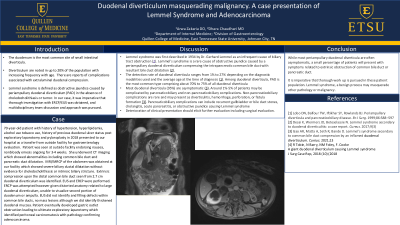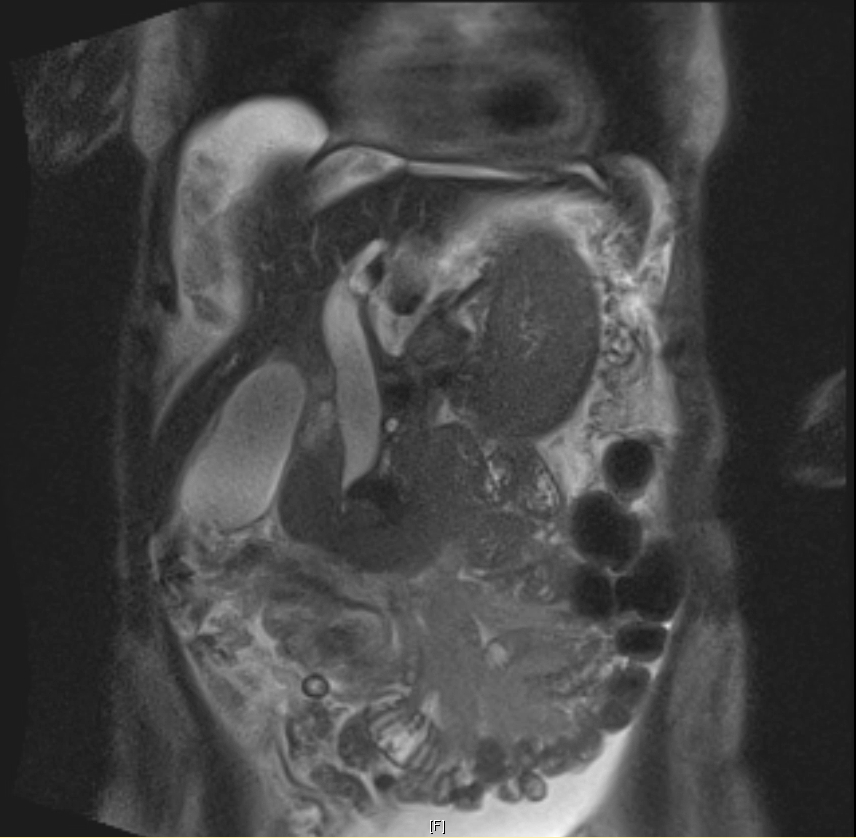Sunday Poster Session
Category: Interventional Endoscopy
P1076 - Duodenal Diverticulum Masquerading Malignancy: A Case Presentation of Lemmel Syndrome and Adenocarcinoma
Sunday, October 27, 2024
3:30 PM - 7:00 PM ET
Location: Exhibit Hall E

Has Audio
- AZ
Arwa Zakaria, DO
East Tennessee State University Quillen College of Medicine
Johnson City, TN
Presenting Author(s)
Arwa Zakaria, DO
East Tennessee State University Quillen College of Medicine, Johnson City, TN
Introduction: The duodenum is the most common site of small intestinal diverticula. Diverticulum are noted in up to 20% of the population with increasing frequency with age. There are reports of complications associated with extraluminal duodenal compression. Lemmel syndrome is defined as obstructive jaundice caused by periampullary duodenal diverticulum (PAD) in the absence of choledocholithiasis or tumor. The syndrome is not often reported as most patients are asymptomatic. However, in our case, it was imperative that thorough investigation with ERCP/EUS was obtained, and multidisciplinary team discussion and approach was pursued.
Case Description/Methods: 70-year-old patient with history of hypertension, hyperlipidemia, alcohol use tobacco use, history of previous duodenal ulcer status post exploratory laparotomy and pyloroplasty in 2018 presented to our hospital as a transfer from outside facility for gastroenterology evaluation. Patient was seen at outside facility endorsing nausea, nonbloody emesis ongoing for 3-4 weeks. She underwent CT imaging which showed abnormalities including common bile duct and pancreatic duct dilatation. MRI/MRCP of the abdomen was obtained at our facility which showed severe biliary ductal dilatation without evidence for choledocholithiasis or intrinsic biliary stricture. Extrinsic compression upon the distal common bile duct seen from 2.7 cm duodenal diverticulum was identified. EUS and ERCP were performed. ERCP was attempted however given distorted anatomy related to large duodenal diverticulum, unable to visualize second portion of duodenum or ampulla. EUS did not identify and filling defects within common bile ducts, no mass lesions although we did identify thickened duodenal mucosa. Patient eventually developed gastric outlet obstruction leading to ultimate exploratory laparotomy which identified peritoneal carcinomatosis with pathology confirming adenocarcinoma.
Discussion: While most periampullary duodenal diverticula are often asymptomatic, a small percentage of patients will present with symptoms related to extrinsic obstruction of common bile duct or pancreatic duct. It is imperative that thorough work up is pursued in these patient population. Lemmel syndrome, a benign process may masquerade other pathology or malignancy.

Disclosures:
Arwa Zakaria, DO. P1076 - Duodenal Diverticulum Masquerading Malignancy: A Case Presentation of Lemmel Syndrome and Adenocarcinoma, ACG 2024 Annual Scientific Meeting Abstracts. Philadelphia, PA: American College of Gastroenterology.
East Tennessee State University Quillen College of Medicine, Johnson City, TN
Introduction: The duodenum is the most common site of small intestinal diverticula. Diverticulum are noted in up to 20% of the population with increasing frequency with age. There are reports of complications associated with extraluminal duodenal compression. Lemmel syndrome is defined as obstructive jaundice caused by periampullary duodenal diverticulum (PAD) in the absence of choledocholithiasis or tumor. The syndrome is not often reported as most patients are asymptomatic. However, in our case, it was imperative that thorough investigation with ERCP/EUS was obtained, and multidisciplinary team discussion and approach was pursued.
Case Description/Methods: 70-year-old patient with history of hypertension, hyperlipidemia, alcohol use tobacco use, history of previous duodenal ulcer status post exploratory laparotomy and pyloroplasty in 2018 presented to our hospital as a transfer from outside facility for gastroenterology evaluation. Patient was seen at outside facility endorsing nausea, nonbloody emesis ongoing for 3-4 weeks. She underwent CT imaging which showed abnormalities including common bile duct and pancreatic duct dilatation. MRI/MRCP of the abdomen was obtained at our facility which showed severe biliary ductal dilatation without evidence for choledocholithiasis or intrinsic biliary stricture. Extrinsic compression upon the distal common bile duct seen from 2.7 cm duodenal diverticulum was identified. EUS and ERCP were performed. ERCP was attempted however given distorted anatomy related to large duodenal diverticulum, unable to visualize second portion of duodenum or ampulla. EUS did not identify and filling defects within common bile ducts, no mass lesions although we did identify thickened duodenal mucosa. Patient eventually developed gastric outlet obstruction leading to ultimate exploratory laparotomy which identified peritoneal carcinomatosis with pathology confirming adenocarcinoma.
Discussion: While most periampullary duodenal diverticula are often asymptomatic, a small percentage of patients will present with symptoms related to extrinsic obstruction of common bile duct or pancreatic duct. It is imperative that thorough work up is pursued in these patient population. Lemmel syndrome, a benign process may masquerade other pathology or malignancy.

Figure: Coronal View of Periampullary Diverticulum
Disclosures:
Arwa Zakaria indicated no relevant financial relationships.
Arwa Zakaria, DO. P1076 - Duodenal Diverticulum Masquerading Malignancy: A Case Presentation of Lemmel Syndrome and Adenocarcinoma, ACG 2024 Annual Scientific Meeting Abstracts. Philadelphia, PA: American College of Gastroenterology.
